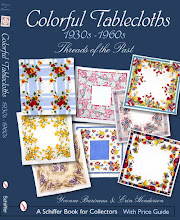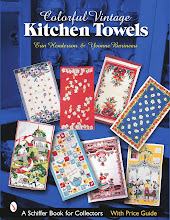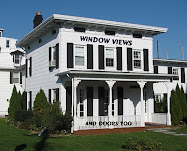 Saw these lovely glass doorknobs in Abingdon last weekend. There is something about a glass doorknob that speaks to me. There is substance and charm. Now do the door knobs in our present day homes provide that? I think not.
Saw these lovely glass doorknobs in Abingdon last weekend. There is something about a glass doorknob that speaks to me. There is substance and charm. Now do the door knobs in our present day homes provide that? I think not. Thought you might enjoy a little history about these beauties:
History
The technology for pressing melted or molten glass into molds was developed in 1826. Glass knobs were made then, but they did not become popular until after 1917 when the United States joined World War I. Metals that had been previously used for doorknobs, such as iron, brass and bronze, were needed to manufacture airplanes and other necessities for the war.
Time Frame
By 1920, doorknobs made from crystal and cut glass were widely manufactured and sold. Glass doorknobs remained popular until Americans' preferences reverted back to metals in the 1950s. Today, the use of art glass in doorknobs is an expensive design choice when compared with the mass produced variety that you can purchase at the hardware store.
Types
Most of the antique and vintage glass knobs manufactured were clear, and colored glass was used less frequently. Cobalt blue was a popular color, along with a lighter robin's egg blue. Green, violet, red, vaseline glass and white milk glass were made more sparingly.
Considerations
If you're shopping for a bit of history for your home, you can find antique and vintage glass doorknobs starting at around $20 per pair for the more common 12-sided clear glass models. Cut crystal balls are the most expensive as they are the most difficult to find. Prices for these sets can be as much as $500. As with any antique or collectible, the more rare a style or color is, the more you can expect to pay. Cobalt, red and Vaseline glass knobs are the most prized colors for antique and vintage knobs. Condition is also a consideration as you will find some with chipped or broken glass, which is nearly impossible to repair.
Features
Historically, glass knobs had 6, 8 or 12 facets. The available shapes ranged from globes to ovals, and you could clearly see the particular star, pinprick or bullet designs that were made into the base of the glass knob. Today's reproductions are made from lead crystal and, though they are beautiful, you will see a difference if you look at the old and new, side by side. (taken from here HISTORY OF GLASS DOOR KNOBS)
The technology for pressing melted or molten glass into molds was developed in 1826. Glass knobs were made then, but they did not become popular until after 1917 when the United States joined World War I. Metals that had been previously used for doorknobs, such as iron, brass and bronze, were needed to manufacture airplanes and other necessities for the war.
Time Frame
By 1920, doorknobs made from crystal and cut glass were widely manufactured and sold. Glass doorknobs remained popular until Americans' preferences reverted back to metals in the 1950s. Today, the use of art glass in doorknobs is an expensive design choice when compared with the mass produced variety that you can purchase at the hardware store.
Types
Most of the antique and vintage glass knobs manufactured were clear, and colored glass was used less frequently. Cobalt blue was a popular color, along with a lighter robin's egg blue. Green, violet, red, vaseline glass and white milk glass were made more sparingly.
Considerations
If you're shopping for a bit of history for your home, you can find antique and vintage glass doorknobs starting at around $20 per pair for the more common 12-sided clear glass models. Cut crystal balls are the most expensive as they are the most difficult to find. Prices for these sets can be as much as $500. As with any antique or collectible, the more rare a style or color is, the more you can expect to pay. Cobalt, red and Vaseline glass knobs are the most prized colors for antique and vintage knobs. Condition is also a consideration as you will find some with chipped or broken glass, which is nearly impossible to repair.
Features
Historically, glass knobs had 6, 8 or 12 facets. The available shapes ranged from globes to ovals, and you could clearly see the particular star, pinprick or bullet designs that were made into the base of the glass knob. Today's reproductions are made from lead crystal and, though they are beautiful, you will see a difference if you look at the old and new, side by side. (taken from here HISTORY OF GLASS DOOR KNOBS)






























.jpg)


10 comments:
When I first moved to OR I stayed with my brother. His old house had these knobs on all the doors. I loved that house. I think these knobs are dreamy too. Take care.
Thanks for the info. I have a few glass knobs I've collected over time. Yet they don't work on an RV. I have used some small glass cabnet knobs to replace the uglies. I also have a couple black smooth glass knobs.
Have a great weekend Erin.
Nice shot, not easy to get w/o bounce back of light .. I love door knobs like those .. we had them in our home growing up
I have always loved these knobs. I grew up with them on our doors as well and as a little girl I used to dream about them being diamonds and I was in a palace rich in gold.
Ah, the good memories of yesteryears.
those are pretty knobs. They would be pretty on a closet.....
Gill in Canada
Great and very informative post. The old ways were often better...
Great looking pics of the doorknobs! Wish they still used them in homes today as they add a lot of class to the joint.
Di
The Blue Ridge Gal
Erin - these are so beautiful. I just love crystal, though it doesn't fit my lifestyle right now.
Lovely shot! My interior doors have the original 12-faceted glass knobs (like the one in your photo) used when the house was built. The bronze panels are still here but the skeleton keys are long gone. Thank you for the history, it is very interesting.
Great post! I learned a lot.
Post a Comment